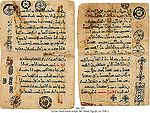- Maronites in Israel
-
Part of a series of articles on the
Maronites
History
History of Phoenicians
Byzantine Empire · Crusades
Marada · Mardaites
History of Lebanon
1958 Lebanon crisis · Lebanese Civil WarReligious affiliation
Maronite Catholic Patriarchate of Antioch and All the East
Lebanese Maronite Order
Mar Bechara Boutros RaïPolitics
Lebanese politics
Lebanese nationalism
Phoenicianism
Kataeb Party · March 14 AllianceLanguages
Cypriot Maronite Arabic · Lebanese Arabic · Aramaic
ArabicCommunities
Cyprus · Israel · Lebanon · Jordan · Syria
DiasporaCategories:- Maronites
- Maronite Church
- Lebanese people
- Eastern Christians
- Ethnic groups in Israel
Wikimedia Foundation. 2010.
Look at other dictionaries:
Maronites — الموارنة ܡܪ̈ܘܢܝܐ … Wikipedia
Maronites — Cet article fait partie d une série sur Les Maronites … Wikipédia en Français
Maronites in Cyprus — Part of a series of articles on the Maronites … Wikipedia
Israel — /iz ree euhl, ray /, n. 1. a republic in SW Asia, on the Mediterranean: formed as a Jewish state May 1948. 5,534,672; 7984 sq. mi. (20,679 sq. km). Cap.: Jerusalem. 2. the people traditionally descended from Jacob; the Hebrew or Jewish people. 3 … Universalium
Arabs in Israel — Israel s Declaration of Independence commits to foster the development of the country for the benefit of all inhabitants . . . based on freedom, justice and peace as envisaged by the prophets of Israel. Israel s non Jewish citizenry is… … Historical Dictionary of Israel
Les moines Maronites — Église maronite Église maronite Fondateur(s) Disciples de Maron Union à Rome N’a jamais été séparée Primat actuel Patriarche Nasrallah Boutros Sfeir … Wikipédia en Français
Demographics of Israel — Further information: Israelis and Demographics of Palestine Total population (As of 2011) 7,798,600 Life expectancy at birth (As of 2008) Men – 79.1 Women – 83.0 Density 321 persons / km2. 91% urban population Distribution of the Jewish … Wikipedia
Eparchie Saint-Maron de Montreal des Maronites — Éparchie Saint Maron de Montréal des Maronites Cet article fait partie d une série sur Les Maronites … Wikipédia en Français
Éparchie saint-maron de montréal des maronites — Cet article fait partie d une série sur Les Maronites … Wikipédia en Français
Éparchie Saint-Maron de Montréal des Maronites — Cet article fait partie d une série sur Les Maronites … Wikipédia en Français
